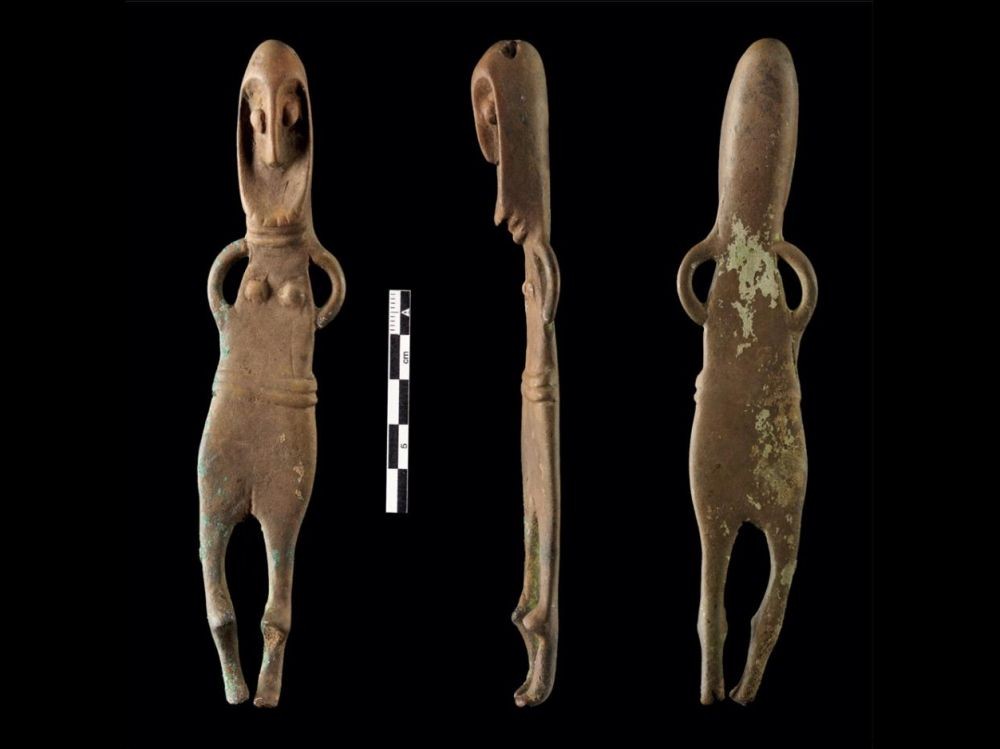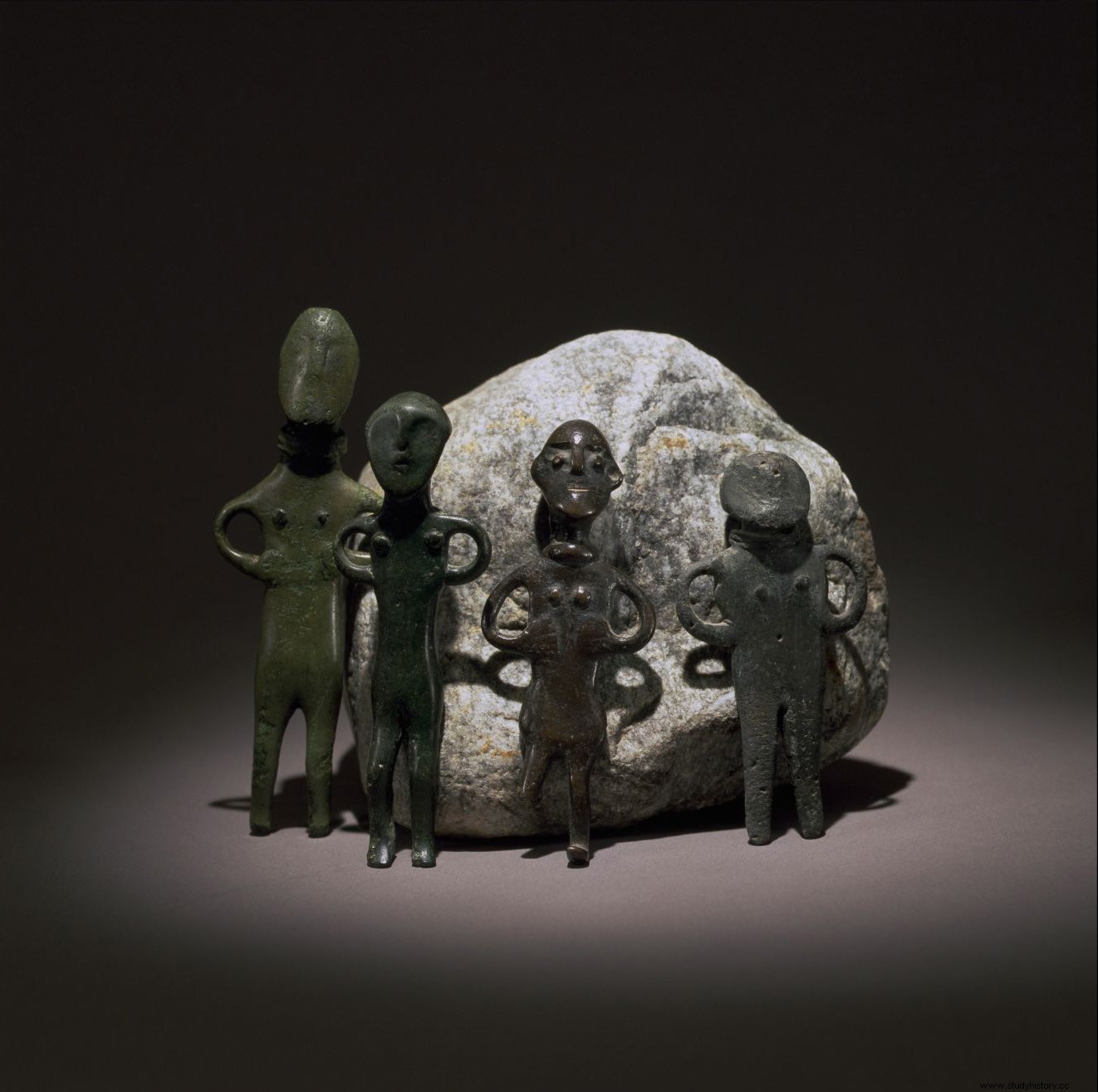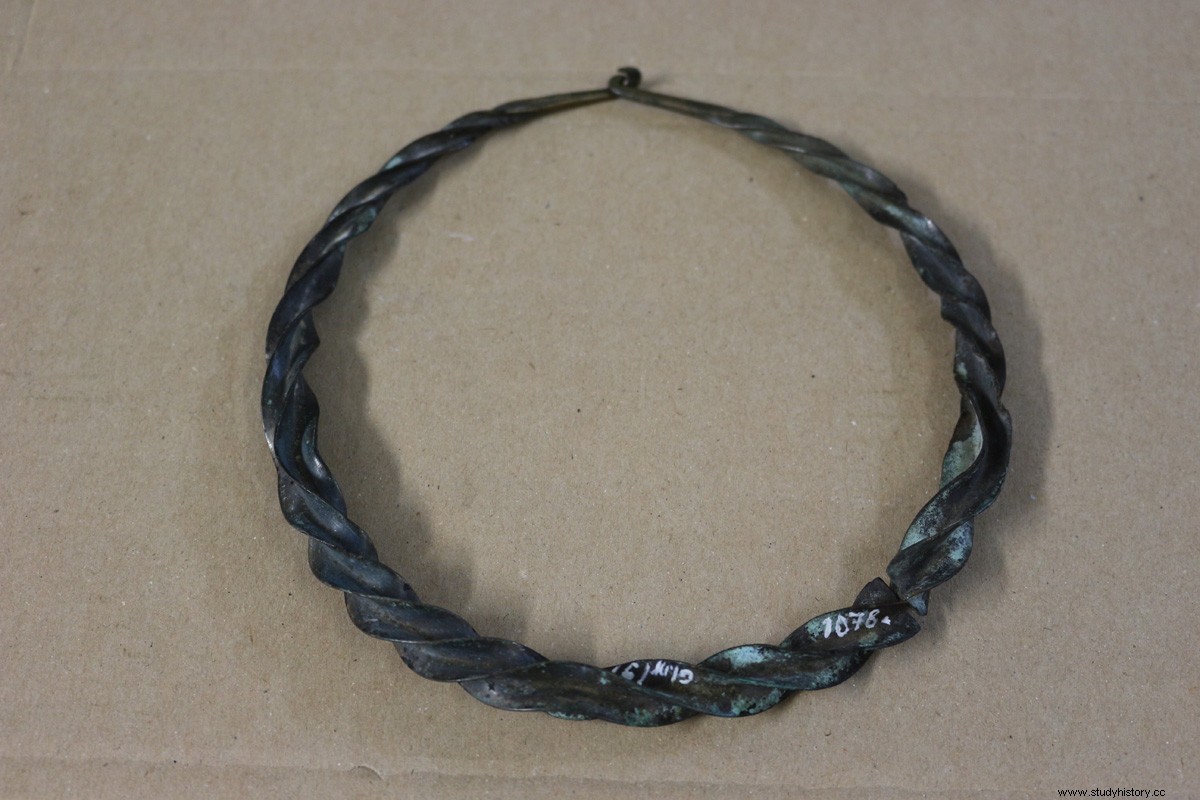A very strange figurine, undoubtedly representing a naked woman, was discovered in northeastern Germany, on the site of the oldest European battlefield. What could have been the function of this peaceful statuette made nearly 2,700 years ago, 600 years after the violent conflict that marked the Tollense Valley?

The bronze figurine found in Tollense, northeastern Germany, depicts a naked woman and dates from the 7th century BCE.
Since the 1990s, Ronald Borgwardt has been diving regularly in the Tollense River in northeastern Germany, and it is thanks to his surveys that archaeologists from the Land of Mecklenburg-Western Pomerania and researchers from the University of Greifswald were able to demonstrate that the valley carved out by the bed of the Tollense was the scene of a terrible battle in the 13th century BC, the oldest in Europe and the largest in the Bronze Age.
Since then, thousands of artifacts, weapons and bones have been found at a 2.5 kilometer long site, with many more still to be unearthed, as evidenced by a new discovery made in July 2020. It is a reddish-brown anthropomorphic figurine, which, according to the analyzes of the team led by Thomas Terberger, an archaeologist at the University of Göttingen, however, is post-conflict. A new field of questions then opens up:what does it represent, what could it have been used for and, above all, does it have a link with this very special place? This is what the team of German researchers tried to determine in an article just published in the Prähistorische Zeitschrift .
A figurine with feminine attributes
Hidden for several centuries in the peat bed of the Tollense River, the bronze figurine, which measures almost 15 centimeters and weighs 155 grams, is barely corroded. The ovoid head is marked by the prominence of the nose in the extension of the forehead, the eyes are represented by two small buttons, just like the breasts on the trunk. The handsless arms are curved in semi-circles, the waist is underlined by a belt which doubles the rings around the neck, the vulva is marked by a barely visible engraving and a slight vertical cut, the legs are bent with the protruding knees. There is little doubt that the statuette represents a naked woman, who however cannot stand on her feet.
13 "necklace goddesses" have been found around the Baltic
For researchers, it is an "exceptional object ", which they compare to another statuette found in the 19th century at Klein Zastrow, barely 35 km from the Tollense site. The only other figurines of the same type, called "necklace goddesses", have been discovered on several sites. Danish and Swedish bordered by the Baltic Sea:on the island of Seeland (the main island of Denmark, the one that is home to Copenhagen), in Skåne (the southernmost province of Sweden) and in the Swedish county of Västra Götaland ( on the west coast of the country). The set represents a total of 13 statuettes similar in form, although they differ in the details of the representation. The two figurines found in Germany are the largest, and that of Tollense the heaviest The researchers conclude that it is therefore unlikely that these statuettes have a single origin, rather their common point lies in their area of distribution, since they were all found on the coast of the Baltic Sea or near rivers leading to it. What to suggest has a connection with the communication routes of the Western Baltic and a zone of close interaction between Western Pomerania and the regions of the Öresund strait – which separates Swedish Skåne from the Danish island of Seeland. The researchers thus presume that these territories could be connected thanks to boats of the type of the Hjortspring boat, which one often sees represented on the rock engravings of this period.
Since the 1990s, Ronald Borgwardt has been diving regularly in the Tollense River in northeastern Germany, and it is thanks to his surveys that archaeologists from the Land of Mecklenburg-Western Pomerania and researchers from the University of Greifswald were able to demonstrate that the valley carved out by the bed of the Tollense was the scene of a terrible battle in the 13th century BC, the oldest in Europe and the largest in the Bronze Age.
Since then, thousands of artifacts, weapons and bones have been found at a 2.5 kilometer long site, with many more still to be unearthed, as evidenced by a new discovery made in July 2020. It is a reddish-brown anthropomorphic figurine, which, according to the analyzes of the team led by Thomas Terberger, an archaeologist at the University of Göttingen, however, is post-conflict. A new field of questions then opens up:what does it represent, what could it have been used for and, above all, does it have a link with this very special place? This is what the team of German researchers tried to determine in an article just published in the Prähistorische Zeitschrift .
A figurine with feminine attributes
Hidden for several centuries in the peat bed of the Tollense River, the bronze figurine, which measures almost 15 centimeters and weighs 155 grams, is barely corroded. The ovoid head is marked by the prominence of the nose in the extension of the forehead, the eyes are represented by two small buttons, just like the breasts on the trunk. The handsless arms are curved in semi-circles, the waist is underlined by a belt which doubles the rings around the neck, the vulva is marked by a barely visible engraving and a slight vertical cut, the legs are bent with the protruding knees. There is little doubt that the statuette represents a naked woman, who however cannot stand on her feet.
13 "necklace goddesses" have been found around the Baltic
For researchers, it is an "exceptional object ", which they compare to another statuette found in the 19th century at Klein Zastrow, barely 35 km from the Tollense site. The only other figurines of the same type, called "necklace goddesses", have been discovered on several sites. Danish and Swedish bordered by the Baltic Sea:on the island of Seeland (the main island of Denmark, the one that is home to Copenhagen), in Skåne (the southernmost province of Sweden) and in the Swedish county of Västra Götaland ( on the west coast of the country). The set represents a total of 13 statuettes similar in form, although they differ in the details of the representation. The two figurines found in Germany are the largest, and that of Tollense the heaviest The researchers conclude that it is therefore unlikely that these statuettes have a single origin, rather their common point lies in their area of distribution, since they were all found on the coast of the Baltic Sea or near rivers leading to it. What to suggest has a connection with the communication routes of the Western Baltic and a zone of close interaction between Western Pomerania and the regions of the Öresund strait – which separates Swedish Skåne from the Danish island of Seeland. The researchers thus presume that these territories could be connected thanks to boats of the type of the Hjortspring boat, which one often sees represented on the rock engravings of this period.

Statuettes found in Scania . © Christer Ählin / Historiska Museet Stockholm
Twisted necklaces as clues
To date the figurine, researchers rely on a detail that could have passed for a purely feminine attribute:the two rings represented around her neck. Towards the end of the Bronze Age, twisted torques (Wendelringe ) were deposited in pairs in the bogs as funerary offerings; some deceased women also wore them around their necks. On some of the figurines discovered in Sweden, the neck jewelry can be seen to be decorated with alternating notches, which identifies them as twisted rings. This feature then allows us to deduce that all these statuettes were probably made at the end of the 7th century BC.

Late Bronze Age necklace type Wendelring in bronze, twisted after being cast . © Sörmlands Museum
Neither goddess nor weight measurement system
It remains to understand what was the function of this figurine. To solve this enigma, the German researchers first take up the various hypotheses considered about the "necklace goddesses" found in the past. To the eyes of the first Swedish researchers who examined them, the statuettes did indeed appear to represent a goddess, but, since these figures are artistically inferior to other statuettes dating from the Bronze Age, they surmised that they could be cheap mass products for poor people. For the German researchers, the very low number of statuettes found, however, contradicts this theory.
Second hypothesis, put forward by Swedish archaeologist Mats Malmer:the figurines could represent the elements of a weight system. Based on their respective masses, we can indeed approximately deduce a unit of the order of 26 grams. The Tollense statuette could fit into this scheme since it weighs approximately 6x26 grams. However, the diversity of the representation of these figurines leaves doubt that it can be a question of weight, retort the German researchers. At most they could be weight-regulated objects, corresponding to a measured amount of metal, but there is still a lack of data on the use of weights during this period in the region, they add. The only known figurative weights which would have been current in a nearby region, Lusatia, are the Kanneurensteine , stones of elongated shape, grooved at the level of their diameter. This hypothesis is therefore not rejected, but it cannot be confirmed in the current state of knowledge. Moreover, just like the previous hypothesis, the low number of figurines found seems a priori invalidate their use in a possible weight system.
A deposit as a commemoration?
Supporters of another interpretation, the German researchers retain as a major clue the location of the sites where the statuettes were found. All of them were discovered in wet or formerly wet areas. They thus envisage deliberate deposits in places which at the time were highly significant, because the aquatic and humid zones were then considered as transition zones to the underworld. In addition, all discovery sites also correspond to communication routes. As evidenced by the remains of a causeway built in the late 19th century BCE south of the Tollense archaeological site, an important road ran through the valley. This 3 meter wide road, built of stone, and even wood in places, with a ford which allowed to cross the river, could have been at the origin of the bloody conflict which occurred more than 500 years later. its layout. The researchers then assume that the deposit of the statuette could also be linked to this landmark battle, the violence of which has undoubtedly permeated the collective memory. It could therefore be a ritual figurine, intended to commemorate the battle of Tollense. This is the most probable hypothesis for the researchers, even if they recognize that the enigma posed by the Tollense figurine and the other "necklace goddesses" is still not solved.
